Posted July 25, 2008
When we present revolutionary ideas, is it just the content that matters, or the form, as well? If the form matters, should it reflect popular styles, or should we constantly push boundaries? Either way has advantages and tradeoffs. Forms of media we are used to (magazines, paperback books, television, blockbuster movies, popular music) have an immediately familiar style, without avant-garde flourishes that might be a distraction from the content. Yet, clearly, it’s for a reason that these come with a ruling class stamp of approval: popular culture often reinforces the undemocratic, oppressive structure of society. Most obvious with television, many forms of popular media transmit ideas in a dramatically one-sided fashion. The viewer has little say over what she sees; we can flip channels or even call into the studio, but never choose what’s on.
If I’ve got my correct academic hat on, I think that the (post?)Marxist thinkers of “The Frankfurt School” grappled with the questions of consciousness in consumer society. But they did so as removed intellectuals and not engaged organizers. More interesting to me are ideas flowing from the experience of revolutionaries, social movements, and oppositional subcultures that have battled the symptoms of capitalism in sundry ways. Overlap, of course, exists among all of these. It’s also useful to divide up different forms of art. How have musicians, graphic designers, photographers, actors, playwrights, and directors dealt with these questions? (At some point I hope to write a eulogy for the thoughtfully designed political button: in the 1970s, they were made with a great deal of care and artistic attention; these days they are boring and tasteless. This, I believe, was a casualty of desktop publishing deskilling the graphic design trade.)
Take the newspaper, for example – a bulwark of any revolutionary’s arsenal, at once an agitator, educator, and organizer. The great Polish socialist Rosa Luxemburg said that “a newspaper should [not] be symmetrical, trimmed like an English lawn, rather, it should be somewhat untamed, like a wild orchard, it should bristle with life and shine with young talents.” This seems to me a description of the lively style of anarchist ‘zines more than the dry, blocky layout of socialist literature, which tend to be modeled on tabloid newspapers from three decades ago… this would be funny if it wasn’t true. Every leaflet is not going to be a masterpiece, but style matters.
I recently got my hands on several copies of The Great Speckled Bird, an Atlanta-based radical and underground newspaper published weekly from 1968 through 1976. The paper’s graphic design, photography, and content strikes a great balance between the orthodox visual presentations of revolutionary organizations and the freaked-out psychedelia of the counterculture. The awesome collages that Emory Douglas produced for the Black Panther Party’s newspaper are another standout example. In a position paper, Douglas argued that revolutionary artists “must constantly be agitating the people,” but first, “make strong roots among the masses of the people.” I interpret this as an emphasizing familiarity with mass culture and media, but through adapting it for revolutionary agitation, transforming its style.
 As incredible as Douglas’ art was, it still remains fairly straightforward in its depiction of people, oppression, and struggle. The collage at right agitates around un- and under-employment of African-Americans in capitalist America. Superimposed on a newspaper’s “Help Wanted” section, a man waits in line at a temp office, with the caption: They tell me there ain’t no jobs – what’s a person to do in order to survive?. Artistically, this is pretty cutting-edge, but I wonder how far from the literal we can stray? I love the European avant garde art movements of the early twentieth century: the challenge from cubists to see all the dimensions of a situation, surrealists’ attempts to question illusion and reality, the celebration (and exoticization, to be fair) of African artistic styles.
As incredible as Douglas’ art was, it still remains fairly straightforward in its depiction of people, oppression, and struggle. The collage at right agitates around un- and under-employment of African-Americans in capitalist America. Superimposed on a newspaper’s “Help Wanted” section, a man waits in line at a temp office, with the caption: They tell me there ain’t no jobs – what’s a person to do in order to survive?. Artistically, this is pretty cutting-edge, but I wonder how far from the literal we can stray? I love the European avant garde art movements of the early twentieth century: the challenge from cubists to see all the dimensions of a situation, surrealists’ attempts to question illusion and reality, the celebration (and exoticization, to be fair) of African artistic styles. 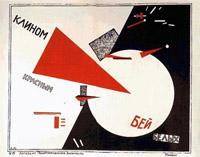
In the early Soviet Union, the constructivist movement sought to express revolutionary fervor through shapes and colors – the painting “Beat the Whites with the Red Wedge,” (at left) for example, cheered on the Bolshevik effort to beat back the invading imperialist armies.
Anyway, enough attempted theorizing. The meat of this post is really a question… I was thinking of this contest between metaphorical (some might say confusing) illustration and literal (some might say boring) illustration, and decided to lean towards the metaphorical/confusing. Currently I’m in Solidarity’s national office in beautiful Detroit. To illustrate a draft document on socialist renewal, I decided to pop outside to the alley in back and capture some dialectical photographs. The idea is that these images depict and contrast the harsh, constraining reality we face with the possibility of growth and transformation. Comrades I’ve shared these photos with have reacted differently – some people like it, some don’t. For the time being, I’m using them (the document itself is still in draft form, anyway). But, what do other folks out there in internet-land think?
I’m not a photographer, so “this looks like that corny shit on motivational posters plastered in corporate cubicle offices” is perfectly OK!
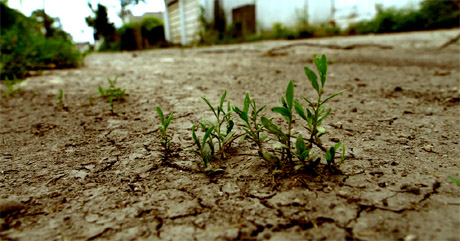

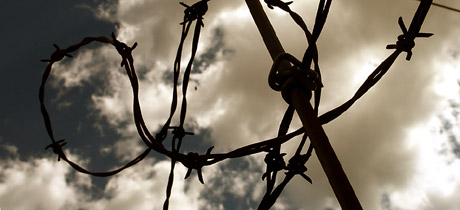

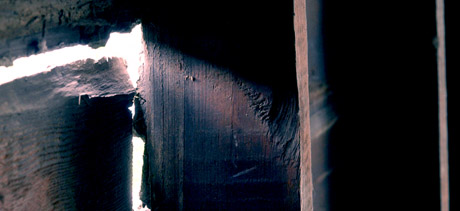
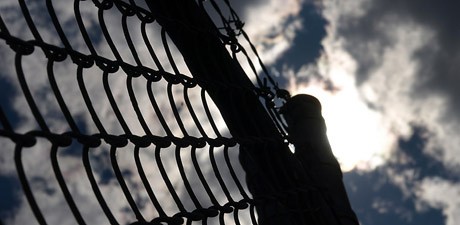

Comments
10 responses to “Unite to Smash Boring Leaflets! Some Thoughts on Revolutionary Imagery”
The glass in the alley-way really stands out for me. It looks like shimmering ice crystals, good for a flyer about melting ice caps/global warming.
I tend to agree with John here on the “we should read more poetry” and also on the fact that our political language is often terrible. I personally am a fan of code switching in political language — of mixing up the theoretically bounded and the fucking vernacular, which is strong and flexible. And the lyric and the emotional!
But I think we can also run the risk of sounding fake as hell, if we stick to one style only — especially if there is an effort to be cutting edge Youthspeak/hipster, and also a danger if we constantly strive to impart a burning political analysis to absolutely every piece of cultural production, à la… who are they? RIM? No, MIM. The guys (I’m pretty sure they are guys, for the most part) with the wacky newspaper that used to debate whether “bitches or hos” was the better gender terminology (I am not joking about this, though the webpage the document was posted on is now gone, and I am sans screencap). Here is a link to their HILARIOUS movie reviews. We don’t want to do this. Although we probably want to read this. http://www.etext.org/Politics/MIM/movies/index.html
I am glad you posted photos, Isaac — and Down with the Modesty that says you are Not a Photographer! Of them, the ones that seem to me both striking and politically useful are the weeds-cracks in pavement thing, the broken window glass in alley photo, and the chain-link fence/sky photo. We need more photos and more images in general.
maeve66 is a middle school teacher in a working class suburb of Oakland.
the british CP’s youth organization “Young Communist League” (YCL) boosted the sale of their (often boring, as far as I know) paper “Challenge” in the mid-1960ies by featuring bands like The Beatles on the first page or by including posters of rock bands
It’s hard to pick pics for a piece I haven’t read. None of those pics say ‘socialist’ or ‘renewal’ to me. And hard to pick appeals to an audience I don’t know and whose tastes I don’t know.
But yes, a lot of old conventional presentation forms don’t work today with people who would like the ideas. And no, we don’t need the retreads of forty or seventy years ago.
For Solidarity’s publications I think the real challenge is design that works within limited graphic means.
The book, “The Cultural Front” by Michael Denning is useful on this point. It’s about how writers, artists and musicians played a serious day to day role in the social movement around the CIO in the 1930s and 1940s. Socialist organizations need to think about how to organize creative people. According to Denning, the CP organized the John Reed clubs in the 1920s, which led directly to the huge movement for “proletarian literature,” in the 1930s, and really gave American culture a leftward direction. One chapter in Denning’s book, “Hot Jazz and the CIO,” talks about how important Jazz was to the social movements of the 30s. This is important to think about now that even mainstream hip-hop artists like Nas and Jay Z are taking real political stances. How can Solidarity (and the left in general) make an impact on American popular culture?
OK I hate to admit a mistake in the blogosphere, but I think I confused a McSweeney’s publication, _The Believer_ with _The Baffler_. Very different I know, somehow I thought I remembered these crowds being linked, but I couldn’t find any evidence of that. Anyway, it’s _The Baffler_ crew who clearly have some Frankfurt School influence going on, e.g. Thomas Frank in _What’s the Matter with Kansas?_ I agree that the Frankfurt School stuff isn’t directly useful for organizing, probably – it’s more useful for analyzing the cultural and historical situation that makes organizing difficult….
Getting back to the question of revolutionary imagery, which you raised, though, I think is a very interesting one in light of the Frankfurt School. One question might be, what are graphical styles that engage people critically, rather than overwhelming their senses (e.g. fascist aesthetic, sometimes seen in some Stalinist forms as well) or lending themselves immediately to commodification (e.g. hipsterism, the appropriation of left and radical imagery for nonpolitical consumption).
It seems to me that the latter problem is especially vexing today, given the extraordinary ability of culturally radical smallholder capitalists to redeploy bits of culture. I’m not sure if there is a left imagery “out there” which resists commodification and sensory overwhelm while remaining engaging especially to lots of non-elites. It may be more a case of being aware of the pitfalls we face, and of the need to continally be creative, since the things we’ve already created can be so efficiently used against us.
I can rank the photos, or their political usefulness, on the basis of my immediate reactions to them, what immediate symbolic connections arise.
So, the first two, with the weeds sprouting in cracked earth road, and then the tracks of tires suggesting a path to the future, are good for this purpose. The next four I’m not so sure about; e.g. The last photo of the fence and the sky is beautiful, but it makes me think about baseball above all else.
On the form/content question, I lean heavily on the form side, even if we can’t really separate them. I think the real content and substance, or form of feeling, is powerfully (or not) and deeply (or not) expressed in the form. Thus it is no accident that the revolutionaries of the early 20th century produced so many incisive and deep works of protest and agitation. I love the Luxemburg quote, and think her “Junius Pamphlet” is one of the best-ever pieces of political writing. We should be schooled in it. Lenin, of course, was a great polemicist, with supreme gifts of sarcasm and invective. (That this style may have had some seriously tragic consequences for our movement is another matter.)
By comparison, our political language is cold and dry, formulaic. And these qualities relate to the relatively weak position world-historically of our movement. It’s one thing to be right, have all of your facts lined up, and quite another to really speak to people and move them in their souls. Which is why we should all read more poetry.
For example, Garcia Lorca on New York:
“No, no. I denounce.
I denounce the conspiracy
of those deserted offices
swept clean of agony
that erase the designs of the forest,
and I offer myself to be eaten by the crushed cows
when their screams fill the valley
where the Hudson gets drunk on oil.”
Finally, I remember Marcuse’s One-Dimensional Man had a really amazing analysis of our clipped news-speak and it’s effect on the form of our thoughts, on how our language opens and closes certain possibilities for thought, and action.
I’m so glad that some one else is thinking about this topic.
I think that it’s almost impossible to push the boundaries with visual art and graphic design nowadays. People are so bombarded with visual-art by the commercial media that they don’t relate to art in the same way that they used to. Most of the time I inadvertently tune-out when i see graphic design or visual art of any kind.
How much of a role should visual art play in building class consciousness?
I edited that sentence out of concern it would come across as anti-intellectual, then changed it back to the original Frankfurt School diss. My intention was to distinguish between those dudes (not sure which theories are associated with which, honestly) and, say, Lenin, who thought about the newspaper less as a cultural analyst than as an organizer.
I’m interested in the McSweeney’s connection. What’s up with that?
Adorno certainly turned away from praxis and political action, but that can’t be said of the entire Frankfurt School. Marcuse was an important figure for the New Left, and Erich Fromm, well, diverged from what we would call the Left, but remained practically engaged. The guys around McSweeney’s also have a lot of badground in this tradition, albeit with a spin that walks the line between liberalism, radical liberalism, and a detached hipster stance. Albeit none of this is directly engaged with revolutionary left praxis in a positive, cultural-symbolic level. I think the critical question remains, though, of how the Left can not just create or engage in a counter-culture, but how we can respond to the development of mass culture. We don’t have to embrace Adorno’s profound pessimism to get something out of his delineation of the problem.